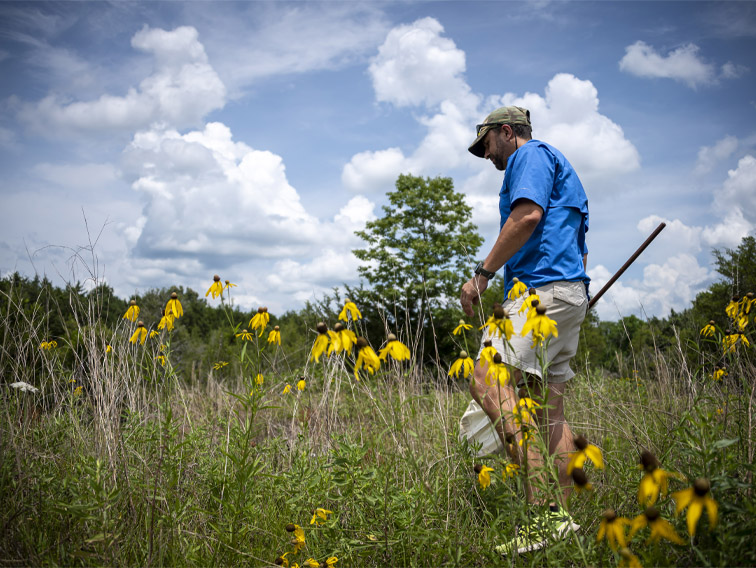The information presented on this page may be dated. It may refer to situations which have changed or people who are no longer affiliated with the university. It is archived as part of Mississippi State University's history.
Grasslands once covered an estimated ⅓ to ½ of the Southeastern U.S., or an estimated 120 million acres, as some of the most biologically diverse ecosystems in America. As the first areas to be settled because of fewer trees and better soils, grasslands were carved out into different landscapes. It's in these fragmented spaces dotted across 24 states, including Mississippi, that Dr. JoVonn Hill, a MAFES scientist and assistant professor in the Department of Biochemistry, Molecular Biology, Entomology and Plant Pathology, has discovered a little over 30 new grasshopper species. It is also where many more insects, flora, and fauna are in peril of losing ground and disappearing forever.
The Mississippi Entomological Museum where Hill is director serves as the entomology arm for the Southeastern Grassland Initiative, or SGI, a collaboration of leaders in international biodiversity led by Austin Peay State University's Center of Excellence for Field Biology.
Hill is part of a consortium of academic, federal, and state biologists brought together by SGI who are all invested in finding ways to save grassland ecosystems across the Southeast. The group recently published a white paper for the United States Geological Survey, that provides recommendations on improving species assessments under the U.S. Endangered Species Act. The study, which assessed the implications for multispecies conservation challenges worldwide, was also published in Conservation Biology.
Interestingly, endangered species aren't the only ones who inhabit grasslands. Species yet to be discovered also make their homes in these ecosystems.
"Endangered species in grasslands include the red cockaded woodpecker, indigo snake, gopher tortoise and more. In addition to those, we're still discovering species in southeastern grasslands. For instance, in 2015, I described 21 new species of grasshoppers from the eastern U.S. and all of them are grassland species. Many of these species are only found in these small grassland remnants that still exist and we could have easily lost them forever without even knowing they existed," Hill said.
The study began as an event held in January 2020 and sponsored by the U.S. Geological Survey, Bridgestone Americas, and SGI, where stakeholders were a part of a World Café workshop in which they concentrated on five categories of threats to grassland species and ecosystems. The teams focused on habitat loss, climate change, altered disturbance regimes or how a disturbance such as fire can disrupt an ecosystem over space and time, invasive species, and localized impacts.
"The goal of this collaboration was to see what the conservation needs are for southeastern grasslands. It's been a greatly understudied and underappreciated system in the Southeast," Hill said.
The team recommended that the U.S. Fish and Wildlife Service (USFWS) adopt an ecosystem approach to species conservation in southeastern grasslands, noting that such an approach would prove beneficial for both cost-savings and conservation alike.
"Currently, under the Environmental Species Act, any species that is endangered or proposed as endangered requires a Species Status Assessment or SSA, a comprehensive account of everything about that species. Creating an SSA is time consuming and costly and currently the USFWS faces a backlog of hundreds of species awaiting listing decisions. Given how many endangered species inhabit grasslands, our team recommended that modifications be made to how U.S. Fish and Wildlife assesses endangered species conservation, specifically in grasslands. By focusing on the habitat instead of a single species, you're taking a more ecological approach because you're protecting more species than just one," Hill said.
Instead of focusing on individual species, the group suggested assessments focus on ecosystem threats. They laid out scientific needs for each threat, which they deemed critical to consider when establishing ecosystem-wide SSAs. For instance, regarding habitat loss, the team found critical needs for identifying grassland areas most vulnerable to land-use change and establishing improved understanding of how habitat loss impacts the intricacies of animal-plant interactions, among other things. A need the team found in reference to climate change included identifying grassland species unable to spatially shift in response to a changing climate. To better understand altered disturbance regimes, the team found a need to better identify how fire impacts other grassland ecosystems besides long leaf pine savannas, which has been widely documented. On the invasive species front, researchers identified the need to establish what influences a grassland community's susceptibility to invasion, among other factors. The team also discussed how localized impacts needed to be addressed.
The approach, in part, is ideal because of the rich biodiversity found in grasslands. According to the paper, more than 600 species listed under the U.S. Endangered Species Act are concentrated in southeastern grasslands.
Hill said the work is a promising step in promoting grassland conservation.
"Raising awareness about conserving southeastern grasslands has long been a passion of mine. This study is the first where it's laid out how we can use grasslands as an example for multispecies conservation. These grasslands are troves of biodiversity still and the Mississippi Entomological Museum has focused on grasslands going back several years. Our big picture objective is to modify how the U.S. Fish and Wildlife Service alters their SSA to focus on habitat instead of species," Hill said.
Dr. Dwayne Estes, executive director of the Southeastern Grassland Initiative (SGI), noted the importance of partners like Hill and the Mississippi Entomological Museum as critical players in saving the Southeast's grasslands.
"JoVonn and the team at the Mississippi Entomological Museum are so passionate about what they do, and they have expertise in insect biodiversity, which they effectively communicate to a variety of stakeholders including academics, government agencies, and the general public," Estes said.
Estes said MSU's partnership with SGI is growing as the consortium continues to collaborate on several projects aimed at saving southeastern grasslands. Projects in Alabama and Tennessee are underway with a large multistate project focused on national parks on the horizon. Estes notes that insect biodiversity is a critical component of grassland ecosystems.
"Mississippi State is probably one of three of the top places in the Southeast for studying insect biodiversity of grassland ecosystems. That's why they are so important to SGI as we cover a 24-state region because MSU is one of the top leaders in the entire Eastern U.S. for that topic," he said.
In addition to MSU and the Mississippi Entomological Museum, collaborators represent the following organizations: Southeastern Grasslands Initiative, Austin Peay State University; Florida Institute for Conservation Science; U.S. Geological Survey, Lower Mississippi-Gulf Water Science Center and Southeast Climate Adaptation Science Center; K. Gregg Consulting; U.S. Fish and Wildlife Service; Center for Conservation and Sustainable Development, Missouri Botanical Gardens; NatureServe; Natural Areas Registry, Louisiana Department of Wildlife and Fisheries; U.S. Fish and Wildlife Service, National Wildlife Refuge System; North Carolina Natural Heritage Program; Texas A&M University Natural Resource Institute; Texas Parks and Wildlife, Nongame and Rare Species Program; Pennsylvania Natural Heritage Program; Department of Biology, Middle Tennessee State University; North Carolina Botanical Gardens; and the University of North Carolina.
In addition to MSU and the Mississippi Entomological Museum, collaborators represent the following organizations: Southeastern Grasslands Initiative, Austin Peay State University; Florida Institute for Conservation Science; U.S. Geological Survey, Lower Mississippi-Gulf Water Science Center and Southeast Climate Adaptation Science Center; K. Gregg Consulting; U.S. Fish and Wildlife Service; Center for Conservation and Sustainable Development, Missouri Botanical Gardens; NatureServe; Natural Areas Registry, Louisiana Department of Wildlife and Fisheries; U.S. Fish and Wildlife Service, National Wildlife Refuge System; North Carolina Natural Heritage Program; Texas A&M University Natural Resource Institute; Texas Parks and Wildlife, Nongame and Rare Species Program; Pennsylvania Natural Heritage Program; Department of Biology, Middle Tennessee State University; North Carolina Botanical Gardens; and the University of North Carolina.
The goal of this collaboration was to see what the conservation needs are for southeastern grasslands. It's been a greatly understudied and underappreciated system in the Southeast.
Dr. Jovonn Hill
Behind the Science

JoVonn Hill
Assistant Professor; Director, Mississippi Entomological Museum
Education: B.S., Interdisciplinary Science; M.S., Ph.D., Agricultural and Life Science, Mississippi State University
Years At MSU: 16
Focus: Biodiversity of the Southeastern United States and grasshoppers of North America
Passion At Work: I and my team focus on documenting and understanding the biodiversity in the Southeastern United States. We do this primarily by surveying for native and exotic insect species and investigating the effects of land management practices on rare species or ecosystems in the region.


